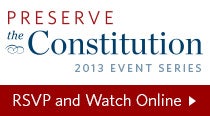This morning marks the official start of the Supreme Court’s 2013–2014 term. One of the cases the Court will decide is National Labor Relations Board v. Noel Canning, which involves a clash between the President and the Senate over recess appointments.
At the end of 2011, the Senate exercised its constitutional authority to deny the confirmation of several nominees President Obama made to the National Labor Relations Board and the Consumer Financial Protection Bureau. Fed up with perceived obstruction by Senate Republicans, President Obama made four purported recess appointments on January 4, 2012. The Senate had been conducting pro forma sessions—brief sessions during which no business is typically conducted—every three days.
President Obama’s move drew substantial criticism and sparked a constitutional debate over the Recess Appointments Clause. Until that point, no President had ever made a recess appointment when the Senate was convening in pro forma sessions every three days. Indeed, for nearly 100 years, the President and Senate had agreed that no recess appointments would be made when the Senate was out for less than 10–20 days.
Article II, Section II, Clause 3 of the U.S. Constitution authorizes the executive to fill “all Vacancies that may happen during the Recess of the Senate.” The Founding Fathers intended recess appointments to be a mechanism for protecting the government from paralysis during long recesses when vacancies arose in the executive and judicial branches. In the early years of our Republic, Senate sessions lasted only a few months at a time, which left several months per year when the Senate would not be in session to vote on any nominations made by the President.
Alexander Hamilton stated in Federalist 67 that the Recess Appointments Clause is “nothing more than a supplement…for the purpose of establishing an auxiliary method of appointment, in cases to which the general method was inadequate.” In other words, the Recess Appointments Clause is a stopgap to enable the government to continue functioning effectively even when the Senate is in recess.
Can President Obama’s purported recess appointments be reconciled with the original meaning of the Recess Appointments Clause and historical practice? Three federal appellate courts have struck down these recess appointments as unconstitutional, and the Supreme Court will consider one of those cases this term. If the historical line of 10–20 days no longer applies, what is the limiting principle for a “recess”? Should Senators be concerned that the President could make recess appointments when they go home for the evening? Or during a lunch break?
These controversial appointments and the subsequent debate have left constitutional scholars with many questions. To learn more about the many issues presented to the Court, please join us at Heritage on Thursday, October 10, at noon or watch online. Senator Mike Lee (R–UT) will address the Senate’s role regarding recess appointments, and noted legal scholars John Yoo and Michael Stern will discuss how the case before the Supreme Court is likely to unfold.
Philip Hammersley is currently a member of the Young Leaders Program at The Heritage Foundation. For more information on interning at Heritage, please click here.

























